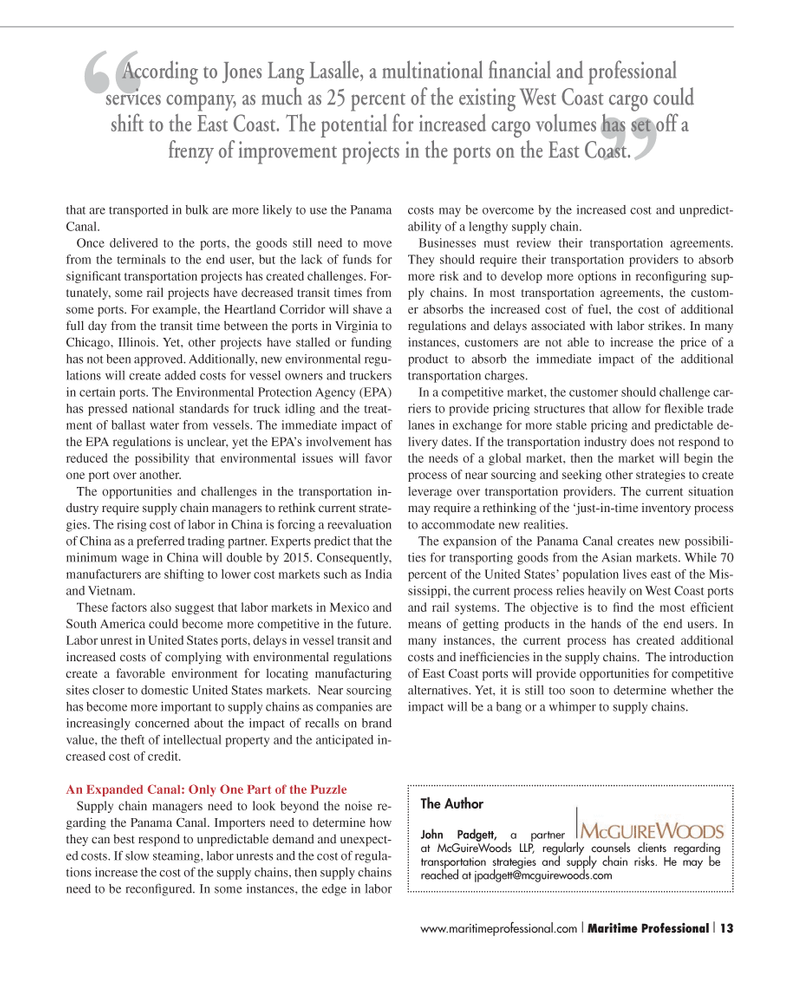
Page 13: of Maritime Logistics Professional Magazine (Q2 2012)
Maritime Risk
Read this page in Pdf, Flash or Html5 edition of Q2 2012 Maritime Logistics Professional Magazine
that are transported in bulk are more likely to use the Panama
Canal.
Once delivered to the ports, the goods still need to move from the terminals to the end user, but the lack of funds for signifi cant transportation projects has created challenges. For- tunately, some rail projects have decreased transit times from some ports. For example, the Heartland Corridor will shave a full day from the transit time between the ports in Virginia to
Chicago, Illinois. Yet, other projects have stalled or funding has not been approved. Additionally, new environmental regu- lations will create added costs for vessel owners and truckers in certain ports. The Environmental Protection Agency (EPA) has pressed national standards for truck idling and the treat- ment of ballast water from vessels. The immediate impact of the EPA regulations is unclear, yet the EPA’s involvement has reduced the possibility that environmental issues will favor one port over another.
The opportunities and challenges in the transportation in- dustry require supply chain managers to rethink current strate- gies. The rising cost of labor in China is forcing a reevaluation of China as a preferred trading partner. Experts predict that the minimum wage in China will double by 2015. Consequently, manufacturers are shifting to lower cost markets such as India and Vietnam.
These factors also suggest that labor markets in Mexico and
South America could become more competitive in the future.
Labor unrest in United States ports, delays in vessel transit and increased costs of complying with environmental regulations create a favorable environment for locating manufacturing sites closer to domestic United States markets. Near sourcing has become more important to supply chains as companies are increasingly concerned about the impact of recalls on brand value, the theft of intellectual property and the anticipated in- creased cost of credit.
An Expanded Canal: Only One Part of the Puzzle
Supply chain managers need to look beyond the noise re- garding the Panama Canal. Importers need to determine how they can best respond to unpredictable demand and unexpect- ed costs. If slow steaming, labor unrests and the cost of regula- tions increase the cost of the supply chains, then supply chains need to be reconfi gured. In some instances, the edge in labor costs may be overcome by the increased cost and unpredict- ability of a lengthy supply chain.
Businesses must review their transportation agreements.
They should require their transportation providers to absorb more risk and to develop more options in reconfi guring sup- ply chains. In most transportation agreements, the custom- er absorbs the increased cost of fuel, the cost of additional regulations and delays associated with labor strikes. In many instances, customers are not able to increase the price of a product to absorb the immediate impact of the additional transportation charges.
In a competitive market, the customer should challenge car- riers to provide pricing structures that allow for fl exible trade lanes in exchange for more stable pricing and predictable de- livery dates. If the transportation industry does not respond to the needs of a global market, then the market will begin the process of near sourcing and seeking other strategies to create leverage over transportation providers. The current situation may require a rethinking of the ‘just-in-time inventory process to accommodate new realities.
The expansion of the Panama Canal creates new possibili- ties for transporting goods from the Asian markets. While 70 percent of the United States’ population lives east of the Mis- sissippi, the current process relies heavily on West Coast ports and rail systems. The objective is to fi nd the most effi cient means of getting products in the hands of the end users. In many instances, the current process has created additional costs and ineffi ciencies in the supply chains. The introduction of East Coast ports will provide opportunities for competitive alternatives. Yet, it is still too soon to determine whether the impact will be a bang or a whimper to supply chains. “ ”
According to Jones Lang Lasalle, a multinational fi nancial and professional services company, as much as 25 percent of the existing West Coast cargo could shift to the East Coast. The potential for increased cargo volumes has set off a frenzy of improvement projects in the ports on the East Coast.
The Author
John Padgett, a partner at McGuireWoods LLP, regularly counsels clients regarding transportation strategies and supply chain risks. He may be reached at [email protected] www.maritimeprofessional.com I Maritime Professional I 13
MP #2 1-17NEW STYLES.indd 13 5/4/2012 4:53:08 PM

 12
12

 14
14
